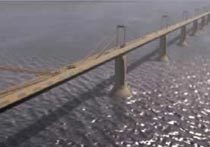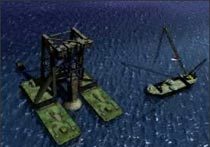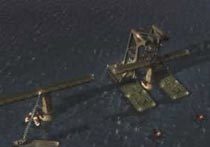
Bering Strait bridge is a hypothetical bridge spanning the relatively narrow straits and shallow Bering between the Chukchi Peninsula in Russia and the Seward Peninsula in the U.S. state of Alaska. In principle, the bridge would provide a land connection between Asia and North America, although there is little infrastructure in areas near Alaska and Russia.
With the Diomede Islands between two peninsulas, the Bering Strait could be spanned by three bridges. Two long bridges, each about 40 miles long, linking the mainland to an island on each side, and a third much shorter between the two islands, giving a total distance of about 80 kilometers. Such length is not unprecedented, as the two long bridges would each shorter than the Jiaozhou Bay Bridge, which is currently the longest sea-crossing bridge in the world. However, the construction of a crossing of the Bering Strait would face exceptional political, engineering and financial barriers.

There have been several proposals for a Bering Strait crossing made by various people, TV, magazines, etc. The names used to include Intercontinental Peace Bridge and Eurasia-America Transport Link. The concept of a land connection across the Bering Strait back before the 20th century. William Gilpin, the first governor of the Colorado Territory, envisioned a vast “Cosmopolitan Railway” in 1890 connecting the world through a series of railways. Two years later, Joseph Strauss, who continued designing more than 400 bridges, including the Golden Gate Bridge, presented the first proposal for a railway bridge Bering Strait thesis.The in its draft was presented to the higher government of the Russian Empire, but was rejected.
A syndicate of American railroad magnates proposed in 1904 a railway from Siberia to Alaska Cape Prince Wales in Alaska through a tunnel under the Bering Strait and across northern Siberia to Irkutsk via Cape Deshnev, Verkhnekolymsk and Yakutsk. The proposal was for a lease of 90 years, and the exclusive mineral rights to 13 km on each side of the right of way. It was discussed by officials and was ultimately dismissed.
 Interest was renewed during the Second World War in 1942-43 with the completion of the Alaska Highway distance between the territory of Alaska with Canada and the continental United States. In 1942, the Foreign Policy Association discussed the road continuing to liaise with Nome near the Bering Strait, connected by highway to the rail head at Irkutsk, using an alternative sea and ferry service air through the Bering Strait.
Interest was renewed during the Second World War in 1942-43 with the completion of the Alaska Highway distance between the territory of Alaska with Canada and the continental United States. In 1942, the Foreign Policy Association discussed the road continuing to liaise with Nome near the Bering Strait, connected by highway to the rail head at Irkutsk, using an alternative sea and ferry service air through the Bering Strait.
In 1958 engineer TY Lin suggested the construction of a bridge across the Bering Strait “to stimulate trade and understanding between the peoples of the United States and the Soviet Union.” Ten years later, he organized the Inter-Continental Peace Bridge Inc., a non-profit organization organized to advance this proposal. During this period, he made a feasibility study of a bridge in the Bering Strait and the estimated cost of $ 1 billion for length of 80 km. In 1994, he updated cost more than $ 4 billion. As Gilpin, Lin envisioned the project as a symbol of international cooperation and unity, and dubbed the Intercontinental Peace Bridge project.
In September 2005 at the launch of the Universal Peace Federation, Sun Myung Moon brought new light to the idea of building the moon called “Bering Strait Peace King Bridge and Tunnel”, calling on all governments world to unite their efforts to achieve world peace. February 10, 2009, Sun Myung Moon “Foundation for Peace and Reunification,” announced a competition to design a bridge across the Strait via the Diomede Islands. Winner (announced June 11, 2009) was a project entitled “Diomede Archipelago.” It offers a series of artificial islands which form two archipelagos extending the two continents and three tunnels connecting the two Diomede islands and archipelagos.

The depth of the water offers little challenge, as the strait is not deeper than 55 m. Tides and currents in the region is not serious. However, the way would be just south of the Arctic Circle, to be subjected to long dark winters and extreme weather conditions, and thus the construction activity is likely to be limited to five months of the year. Time is also a challenge for the exposed steel. In designing Lin, covers all concrete structures, to simplify maintenance and provide additional stiffening. In addition, although there are no icebergs in the Bering Strait, the ice up to 2 m thick are constantly moving during certain seasons, which could produce forces of 5,000 tons short Force on a pier.
